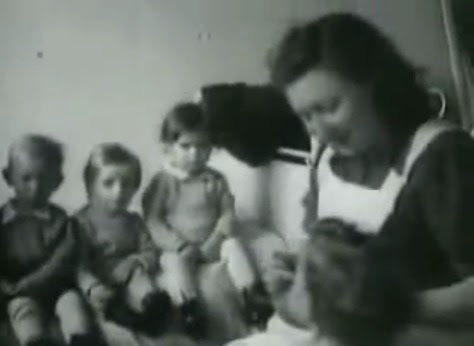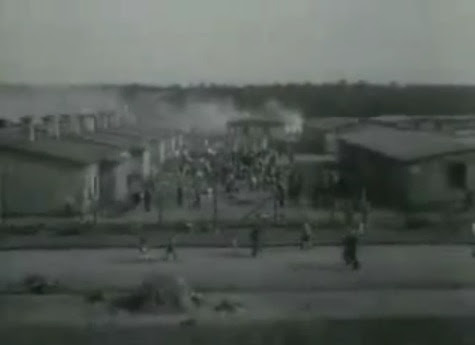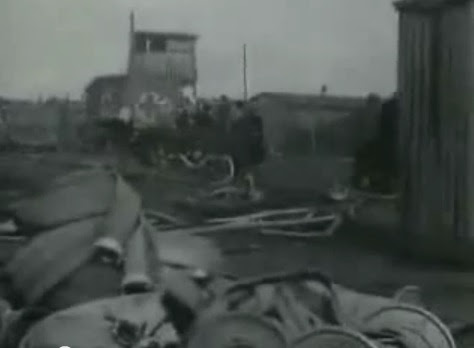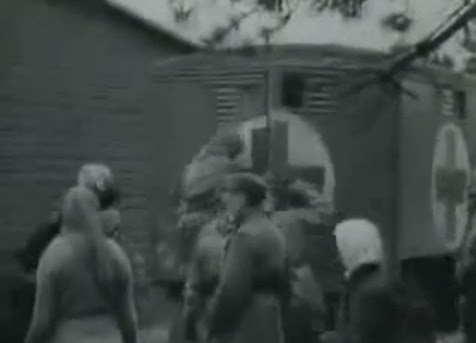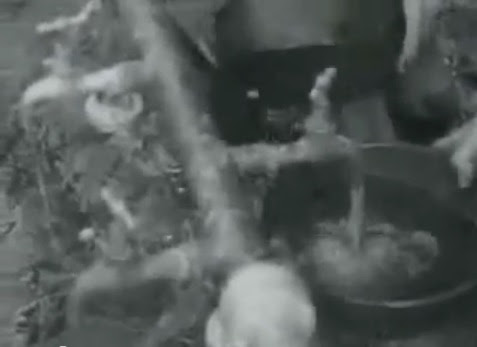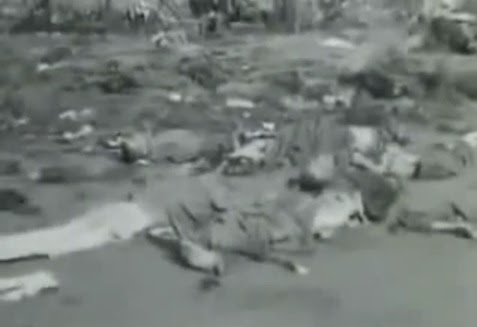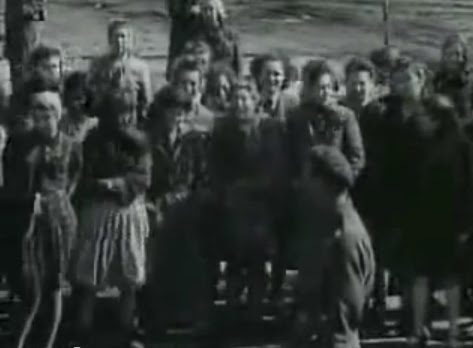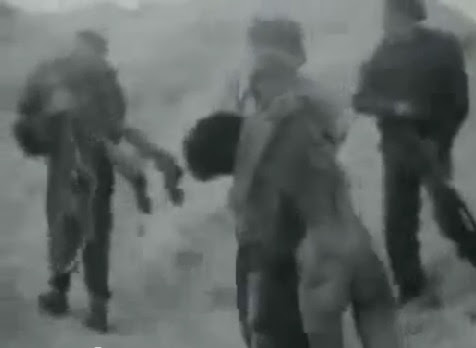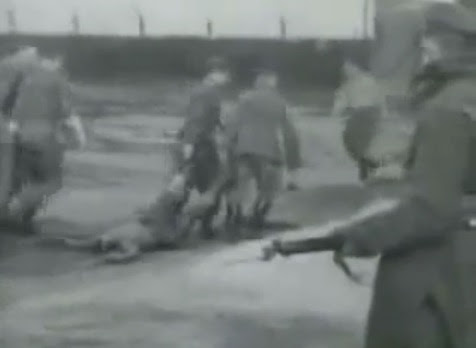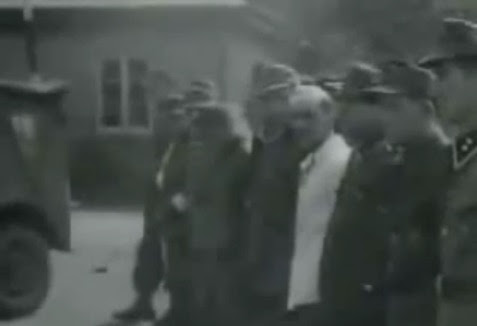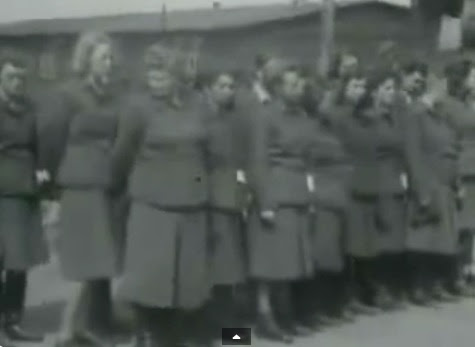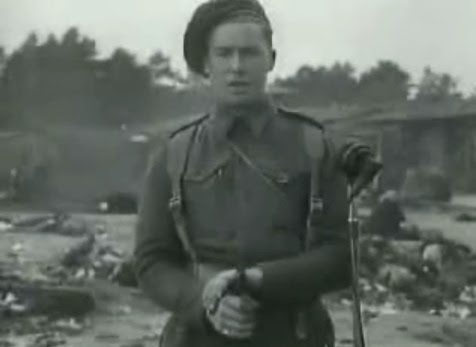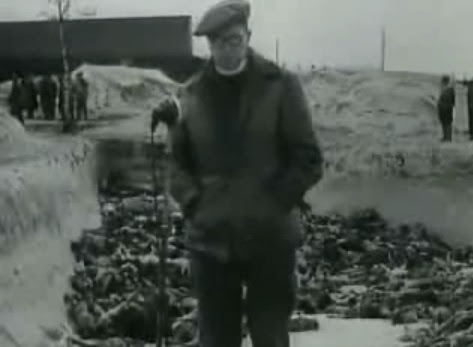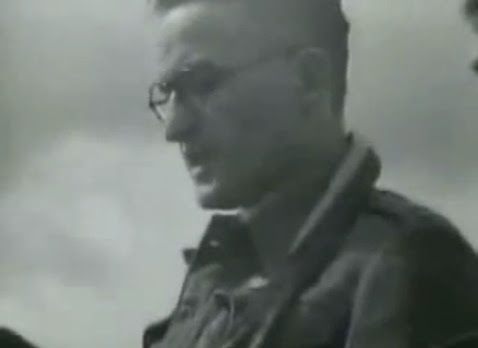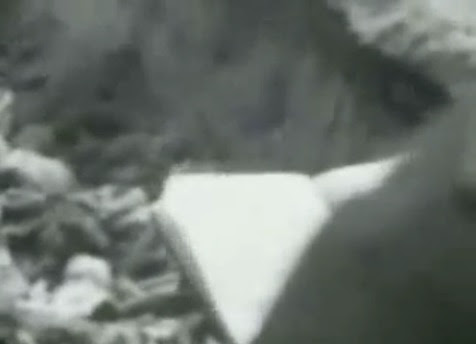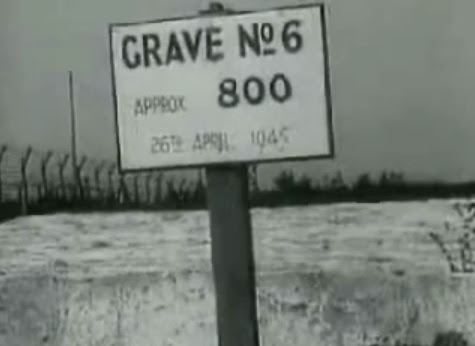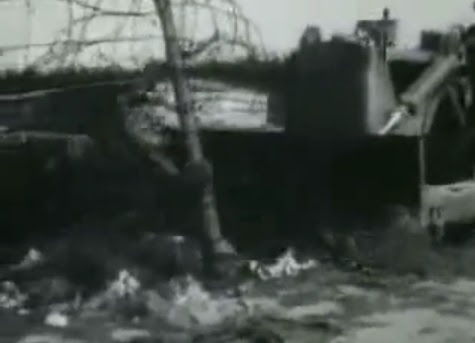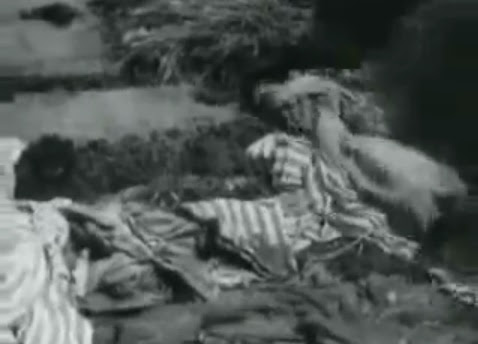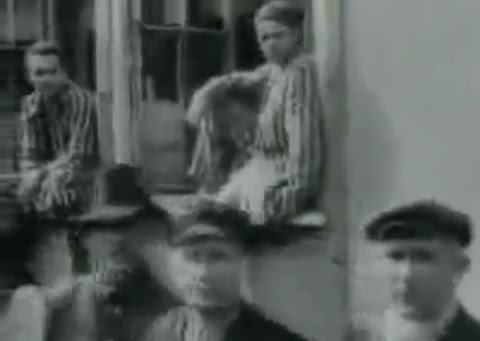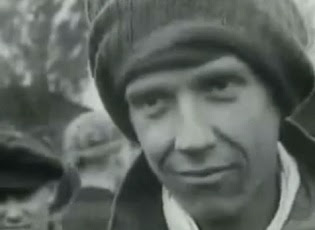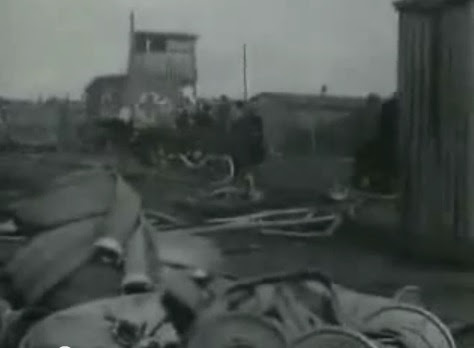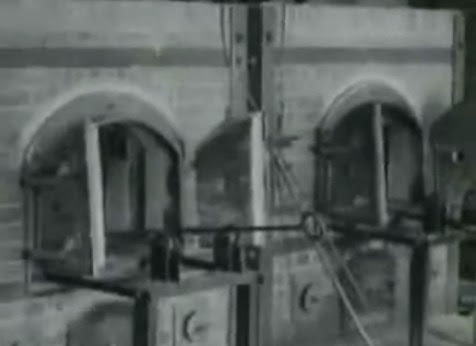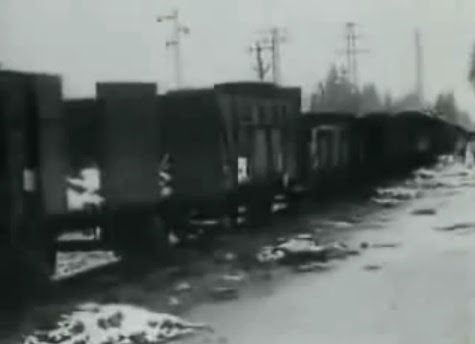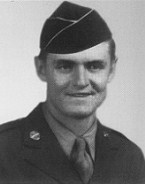
Eisenhower’s Death Camps
Germany’s War by John Wear, Chapter 5:
Allied POW Camps
World War II is often referred to as the “Good War,” a morally clear-cut conflict between good
and evil.1 The “Good War” is also claimed to have led to a good peace. After a period of adjustment,
the United States generously adopted the Marshall Plan and put Germany back on her feet. Germany
with the help of the Allies soon became a prosperous democracy which took her place among the
family of good nations.
The above misleading description does not reflect the horrific treatment of Germans after the
end of the Second World War. In this chapter we will examine the mass
murder of captured German soldiers in the Allied prisoner of war camps.
Introduction to the U.S. & French Prisoner of War Camps
On July 27, 1929, the Allies extended the Protective Regulations of the Geneva Convention for Wounded Soldiers to include prisoners of war (POWs). These regulations state: “All accommodations should be equal to the standard of their troops. The Red Cross supervises. After the end of the hostilities the POWs should be released immediately.” On March 10, 1945, Dwight Eisenhower, the Supreme Allied Commander of the Allied Expeditionary Force, disregarded these regulations by classifying German prisoners captured on German territory as “Disarmed Enemy Forces” (DEFs). The German prisoners were therefore at the mercy of the Allies and were not protected by international law.2
The Western Allies deliberately murdered approximately 1 million disarmed German POWs by means of starvation, exposure, and illness. This Allied atrocity was first publicly exposed in 1989 in the book Other Losses by James Bacque. Dr. Ernest F. Fisher, Jr., a retired colonel in the U.S. Army and a distinguished army historian, wrote the Foreword to the updated version of Other Losses. I quote Dr. Fisher’s Foreword from Other Losses in its entirety:
Over most of the Western Front in late April 1945, the thunder of artillery had been replaced by the shuffling of millions of pairs of boots as columns of disarmed German soldiers marched wearily towards Allied barbed wire enclosures. Scattered enemy detachments fired a few volleys before fading into the countryside and eventual capture by Allied soldiers.
The mass surrenders in the west contrasted markedly with the final weeks on the Eastern Front where surviving Wehrmacht units still fought the advancing Red Army to enable as many of their comrades as possible to evade capture by the Russians.
This was the final strategy of the German High Command then under Grand Admiral Doenitz who had been designated Commander-in-Chief by Adolf Hitler following Reich Marshall Goering’s surrender to the west.
From the German point of view, this strategy delivered millions of German soldiers to what they believed would be the more merciful hands of the Western Allies under supreme military commander General Dwight Eisenhower. However, given General Eisenhower’s fierce and obsessive hatred not only of the Nazi regime, but indeed of all things German, this belief was at best a desperate gamble. More than 5 million German soldiers in the American and French zones were crowded into barbed wire cages, many of them literally shoulder to shoulder. The ground beneath soon became a quagmire of filth and disease. Open to the weather, lacking even primitive sanitary facilities, underfed, the prisoners soon began dying of starvation and disease. Starting in April 1945, the United States Army and the French army casually annihilated about 1 million men, most of them in American camps. Not since the horrors of the Confederate-administered prison at Andersonville during the American Civil War had such cruelties taken place under American military control. For more than four decades this unprecedented tragedy lay hidden in Allied archives.
How at last did this enormous war crime come to light? The first clues were uncovered in 1986 by the author James Bacque and his assistant. Researching a book about Raoul Laporterie, a French Resistance hero who had saved about 1,600 refugees from the Nazis, they interviewed a former German soldier who had become a friend of Laporterie in 1946. Laporterie had taken this man, Hans Goertz, and one other, out of a French prison camp in 1946 to give them work as tailors in his chain of stores. Goertz declared that “Laporterie saved my life, because 25% of the men in that camp died in one month.” What had they died of? “Starvation, dysentery, disease.”
Checking as far as possible the records of the camps where Goertz had been confined, Bacque found that it had been one of a group of three in a system of 1,600, all equally bad, according to ICRC reports in the French army archives at Vincennes, Paris. Soon they came upon the first hard evidence of mass deaths in U.S.-controlled camps. This evidence was found in army reports under the bland heading Other Losses. The terrible significance of this term was soon explained to Bacque and me by Colonel Philip S. Lauben, a former chief of the Germany Affairs Branch of SHAEF.
In the spring of 1987, Mr. Bacque and I met in Washington. Over the following months, we worked together in the National Archives and in the George C. Marshall Foundation in Lexington, Virginia, piecing together the evidence we uncovered. The plans made at the highest levels of the U.S. and British governments in 1944 expressed a determination to destroy Germany as a world power once and for all by reducing her to a peasant economy, although this would mean the starvation of millions of civilians. Up until now, historians have agreed that the Allied leaders soon canceled their destructive plans because of public resistance.
Eisenhower’s hatred, passed through the lens of a compliant military bureaucracy, produced the horror of death camps unequaled by anything in American military history. In the face of the catastrophic consequences of this hatred, the casual indifference expressed by the SHAEF officers is the most painful aspect of the U.S. Army’s involvement.
Nothing was further from the intent of the great majority of Americans in 1945 than to kill off so many unarmed Germans after the war. Some idea of the magnitude of this horror can be gained when it is realized that these deaths exceed by far all those incurred by the German army in the west between June 1941 and April 1945. In the narrative that follows, the veil is drawn from this tragedy.3
Col. Fisher sat on a U.S. Army commission investigating allegations of war crimes committed by American soldiers in 1945. He later said that the commission was “a whitewash.”4
After conducting his research in France, James Bacque realized that a catastrophe had occurred in the American and French POW camps. In the United States National Archives on Pennsylvania Avenue, Bacque found the documents with the heading Weekly Prisoner of War and Disarmed Enemy Forces Report. In each report was the heading Other Losses, which paralleled the statistics he had seen in France.
Bacque reviewed these reports with Col. Philip S. Lauben, who had been chief of the German Affairs Branch of Supreme Headquarters, Allied Expeditionary Force (SHAEF) in charge of prisoner transfers and repatriation. Bacque and Lauben went over the headings in the reports one by one until they got to the heading Other Losses. Lauben said, “It means deaths and escapes.” When Bacque asked how many escapes, Lauben answered “Very, very minor.” Bacque later learned that the escapes were less than one-tenth of 1%.5
Bacque states that because some prisoner documents were deceptive when made, and because many records were destroyed in the 1950s or hidden in euphemisms, the number of dead will always be in dispute. However, there is no question that enormous numbers of men of all ages, plus some women and children, died of starvation, exposure, unsanitary conditions, and disease in American and French POW camps in Germany and France starting in April 1945.
Bacque estimates in Other Losses that the victims undoubtedly number over 790,000, almost certainly over 900,000, and quite likely over a million. The prisoners’ deaths were knowingly caused by army officers who had sufficient resources to keep these prisoners alive. Relief organizations such as the Red Cross that attempted to help prisoners in the American camps were refused permission by the army.6
U.S. Witnesses to AMERICAN & French Prisoner of War Camps
Some American guards have published accounts of their experiences at the Allied POW camps. One of the most credible and informative is that of Martin Brech. The following is the major portion of his account:
In October, 1944, at age 18, I was drafted into the U.S. Army. . . . In late March or early April, 1945, I was sent to guard a POW camp near Andernach along the Rhine. I had four years of high school German, so I was able to talk to the prisoners, although this was forbidden. Gradually, however, I was used as an interpreter and asked to ferret out members of the S.S. (I found none).
In Andernach about 50,000 prisoners of all ages were held in an open field surrounded by barbed wire. The women were kept in a separate enclosure I did not see until later. The men I guarded had no shelter and no blankets; many had no coats. They slept in the mud, wet and cold, with inadequate slit trenches for excrement. It was a cold, wet spring and their misery from exposure alone was evident.
Even more shocking was to see the prisoners throwing grass and weeds into a tin can containing a thin soup. They told me they did this to help ease their hunger pains. Quickly, they grew emaciated. Dysentery raged, and soon they were sleeping in their own excrement, too weak and crowded to reach the slit trenches. Many were begging for food, sickening and dying before our eyes. We had ample food and supplies, but did nothing to help them, including no medical assistance.
Outraged, I protested to my officers and was met with hostility or bland indifference. When pressed, they explained they were under strict orders from “higher up.” No officer would dare do this to 50,000 men if he felt that it was “out of line,” leaving him open to charges. Realizing my protests were useless, I asked a friend working in the kitchen if he could slip me some extra food for the prisoners. He too said they were under strict orders to severely ration the prisoners’ food and that these orders came from “higher up.” But he said they had more food than they knew what to do with and would sneak me some.
When I threw this food over the barbed wire to the prisoners, I was caught and threatened with imprisonment. I repeated the “offense,” and one officer angrily threatened to shoot me. I assumed this was a bluff until I encountered a captain on the hill above the Rhine shooting down at a group of German civilian women with his .45 caliber pistol. When I asked, “Why?” he mumbled, “Target practice,” and fired until his pistol was empty. I saw the women running for cover, but, at that distance, couldn’t tell if any had been hit.
This is when I realized I was dealing with cold-blooded killers filled with moralistic hatred. They considered the Germans subhuman and worthy of extermination; another expression of the downward spiral of racism. Articles in the G.I. newspaper, Stars and Stripes, played up the German concentration camps, complete with photos of emaciated bodies; this amplified our self-righteous cruelty and made it easier to imitate behavior we were supposed to oppose. Also, I think, soldiers not exposed to combat were trying to prove how tough they were by taking it out on the prisoners and civilians.
These prisoners, I found out, were mostly farmers and workingmen, as simple and ignorant as many of our own troops. As time went on, more of them lapsed into a zombie-like state of listlessness, while others tried to escape in a demented or suicidal fashion, running through open fields in broad daylight towards the Rhine to quench their thirst. They were mowed down.
Some prisoners were as eager for cigarettes as for food, saying they took the edge off their hunger. Accordingly, enterprising G.I. “Yankee traders” were acquiring hordes of watches and rings in exchange for handfuls of cigarettes or less. When I began throwing cartons of cigarettes to the prisoners to ruin this trade, I was threatened by rank-and-file G.I.s too.
The only bright spot in this gloomy picture came one night when I was put on the “graveyard shift,” from two to four A.M. Actually, there was a graveyard on the uphill side of this enclosure, not many yards away. My superiors had forgotten to give me a flashlight and I hadn’t bothered to ask for one, disgusted as I was with the whole situation by that time. It was a fairly bright night and I soon became aware of a prisoner crawling under the wires towards the graveyard. We were supposed to shoot escapees on sight, so I started to get up from the ground to warn him to get back. Suddenly I noticed another prisoner crawling from the graveyard back to the enclosure. They were risking their lives to get to the graveyard for something; I had to investigate.
When I entered the gloom of this shrubby, tree-shaded cemetery, I felt completely vulnerable, but somehow curiosity kept me moving. Despite my caution, I tripped over the legs of someone in a prone position. Whipping my rifle around while stumbling and trying to regain composure of mind and body, I soon was relieved I hadn’t reflexively fired. The figure sat up. Gradually, I could see the beautiful but terror-stricken face of a woman with a picnic basket nearby. German civilians were not allowed to feed, nor even come near the prisoners, so I quickly assured her I approved of what she was doing, not to be afraid, and that I would leave the graveyard to get out of the way.
I did so immediately and sat down, leaning against a tree at the edge of the cemetery to be inconspicuous and not frighten the prisoners. I imagined then, and still do now, what it would be like to meet a beautiful woman with a picnic basket, under those conditions as a prisoner. I have never forgotten her face.
Eventually, more prisoners crawled back to the enclosure. I saw they were dragging food to their comrades and could only admire their courage and devotion.
On May 8, V.E. Day, I decided to celebrate with some prisoners I was guarding who were baking bread the other prisoners occasionally received. This group had all the bread they could eat, and shared the jovial mood generated by the end of the war. We all thought we were going home soon, a pathetic hope on their part. We were in what was to become the French zone, where I soon would witness the brutality of the French soldiers when we transferred our prisoners to them for their slave labor camps.
On this day, however, we were happy.
As a gesture of friendliness, I emptied my rifle and stood it in the corner, even allowing them to play with it at their request. This thoroughly “broke the ice,” and soon we were singing songs we taught each other or I had learned in high school German (“Du, du liegst mir im Herzen”). Out of gratitude, they baked me a special small loaf of sweet bread, the only possible present they had left to offer. I stuffed it in my “Eisenhower jacket” and snuck it back to my barracks, eating it when I had privacy. I have never tasted more delicious bread, nor felt a deeper sense of communion while eating it. I believe a cosmic sense of Christ (the Oneness of all Being) revealed its normally hidden presence to me on that occasion, influencing my later decision to major in philosophy and religion.
Shortly afterwards, some of our weak and sickly prisoners were marched off by French soldiers to their camp. We were riding on a truck behind this column. Temporarily, it slowed down and dropped back, perhaps because the driver was as shocked as I was. Whenever a German prisoner staggered or dropped back, he was hit on the head with a club until he died. The bodies were rolled to the side of the road to be picked up by another truck. For many, this quick death might have been preferable to slow starvation in our “killing fields.”
When I finally saw the German women in a separate enclosure, I asked why we were holding them prisoner. I was told they were “camp followers,” selected as breeding stock for the S.S. to create a super-race. I spoke to some and must say I never met a more spirited or attractive group of women. I certainly didn’t think they deserved imprisonment.
I was used increasingly as an interpreter, and was able to prevent some particularly unfortunate arrests. One rather amusing incident involved an old farmer who was being dragged away by several M.P.s. I was told he had a “fancy Nazi medal,” which they showed me. Fortunately, I had a chart identifying such medals. He’d been awarded it for having five children! Perhaps his wife was somewhat relieved to get him “off her back,” but I didn’t think one of our death camps was a fair punishment for his contribution to Germany. The M.P.s agreed and released him to continue his “dirty work.”
Famine began to spread among the German civilians also. It was a common sight to see German women up to their elbows in our garbage cans looking for something edible—that is, if they weren’t chased away.
When I interviewed mayors of small towns and villages, I was told their supply of food had been taken away by “displaced persons” (foreigners who had worked in Germany), who packed the food on trucks and drove away. When I reported this, the response was a shrug. I never saw any Red Cross at the camp or helping civilians, although their coffee and doughnut stands were available everywhere else for us. In the meantime, the Germans had to rely on the sharing of hidden stores until the next harvest.
Hunger made German women more “available,” but despite this, rape was prevalent and often accompanied by additional violence. In particular I remember an eighteen-year-old woman who had the side of her face smashed with a rifle butt and was then raped by two G.I.s. Even the French complained that the rapes, looting and drunken destructiveness on the part of our troops was excessive. In Le Havre, we’d been given booklets warning us that the German soldiers had maintained a high standard of behavior with French civilians who were peaceful, and that we should do the same. In this we failed miserably.
“So what?” some would say. “The enemy’s atrocities were worse than ours.” It is true that I experienced only the end of the war, when we were already the victors. The German opportunity for atrocities had faded; ours was at hand. But two wrongs don’t make a right. Rather than copying our enemy’s crimes, we should aim once and for all to break the cycle of hatred and vengeance that has plagued and distorted human history. This is why I am speaking out now, forty-five years after the crime. We can never prevent individual war crimes, but we can, if enough of us speak out, influence government policy. We can reject government propaganda that depicts our enemies as subhuman and encourages the kind of outrages I witnessed. We can protest the bombing of civilian targets, which still goes on today. And we can refuse ever to condone our government’s murder of unarmed and defeated prisoners of war.
I realize it is difficult for the average citizen to admit witnessing a crime of this magnitude, especially if implicated himself. Even G.I.s sympathetic to the victims were afraid to complain and get into trouble, they told me. And the danger has not ceased. Since I spoke out a few weeks ago, I have received threatening calls and had my mailbox smashed. But it’s been worth it. Writing about these atrocities has been a catharsis of feeling suppressed too long, a liberation, and perhaps will remind other witnesses that “the truth will make us free, have no fear.” We may even learn a supreme lesson from all this: only love can conquer all.7
Martin Brech saw bodies go out of the camp by the truckload, but he was never told how many there were, or where and how they were buried.8 Brech said in 1995 regarding the U.S. Army, “It is clear that in fact it was the policy to shoot any civilians trying to feed the prisoners.” Brech has also confirmed that Eisenhower’s starvation policy was harshly enforced down to the lowest level of camp guard.9
Many other U.S. Army officers and NCOs have admitted that the conditions in the Allied POW camps were lethal for the Germans. Cpl. Daniel McConnell suffered from post-traumatic stress disorder caused by his experiences in a U.S. Army camp at Heilbronn. McConnell had been ordered, despite his ignorance of medicine, to take over Baker # 4, a “hospital” tent at Heilbronn. McConnell writes: “One day while working on a coal detail, I was summoned to the office of the First Sergeant who said, ‘We see from your 201 file you know some German—the guy out in the prison camp is messing up. We’re sending you out to straighten things out.’ ”
The hospital had no medical facilities beyond bottles of aspirin. McConnell writes: “After a tour of inspection, I saw that Baker #4 was a hospital in name only. Not even the most elementary standards of cleanliness were maintained or enforceable. Cleaning compounds and disinfectants were unavailable, not to mention medical and surgical [supplies]. . . . The odor was unendurable. . . . Operations were performed without anesthesia. . . . At night the chatter of a machine gun or the crack of a rifle could be heard as a POW went for the wire to escape.”10
The mud-floored tent was simply a way to assemble dying prisoners convenient to the trucks that would soon take away their corpses. McConnell saw the prisoners die en masse in this camp, and saw the prisoners buried by bulldozers in mass graves. McConnell states: “When a POW died, his remains were taken in a gunny sack to a tent near the main gate. There a medical officer would sign a death certificate, which I would witness. A number of bodies would be taken to a long slit trench outside the camp for mass burial. If next of kin were present (a rare event), a few words were spoken by a clergyman, then a bulldozer would start up and cover the bodies with earth.”
Since McConnell was ordered to supervise all of this without being able to stop it, his guilt never left him. After 50 years McConnell’s mental condition eventually made him physically ill. The Veterans’ Administration, which in 1998 awarded McConnell a 100% medical pension, admitted that McConnell had been injured for life by the horrors he had witnessed in the camp but could not prevent.11
Probably the most eminent of the American eyewitnesses to the camps is Maj. Gen. Richard Steinbach (then a colonel), who was ordered to take over administration of several U.S. Army prison camps near Heilbronn. In his memoirs, Steinbach says that on an inspection tour he found that the conditions in the American camps were terrible. The great majority of the prisoners had no shelter. Most of the prisoners had lost weight, some were suffering from illness, and some were slowly losing their minds. Often far less than the official food allotment of 1,000 calories per day was given to the prisoners, even though Steinbach soon found that sufficient food was available.12
Steinbach knew what had caused the terrible conditions in the American POW camps: “This was caused by the Morgenthau Plan. . . . Morgenthau was venting his pent-up feelings on Germany by starving these men. . . . [His] objective was vengeance rather than promoting U.S. national objectives. Of course, Franklin D. Roosevelt, the president who approved this plan, was also responsible. Worse even than the starvation was the idleness enforced on these people. I was amazed and disgusted at the same time. Was this the American way to treat people, even though some might be criminals? Obviously it was not. I directed the U.S. camp commander to send to the railhead and draw supplementary rations.” Steinbach said that the food and tents were delivered immediately from supplies nearby.13
Gen. Withers Alexander Burress, like Steinbach a member of the Sixth Army command, found the same conditions in his camps. Steinbach says he saw the same things elsewhere: “I inspected other camps and found the same situation, ordering the same remedial action. . . . As soon as I returned to our headquarters, I met with General Burress. He said that the German POW camp was something beyond his comprehension.” Unfortunately, Steinbach was transferred early the next year, and conditions at Heilbronn deteriorated again according to Cpl. Daniel McConnell.14
American prison camps in France were also kept far below the standards set by the Geneva Convention. Lt. Col. Henry W. Allard, who was in charge of some camps in France from late 1944 through May 1945, says that only food rations were sent to the camps. Supplies such as medicine, clothing, fuel, mess kits, and stoves were denied to the prisoners. Allard describes the camps conditions: “The standards of PW [prisoner of war] camps in the ComZ [the U.S. Army’s rear zone] in Europe compare as only slightly better or even with the living conditions of the Japanese PW camps our men tell us about, and unfavorably with those of the Germans.”15
After the war conditions in the American camps grew steadily worse. Col. Philip Lauben later said that the American and French camps in the Vosges region in France were so bad that “the Vosges was just one big death camp.”16
Disastrous overcrowding, disease, exposure and malnutrition were the rule in the U.S. camps in Germany beginning in 1945. U.S. Army Cols. James B. Mason and Charles H. Beasley observed the conditions in the American camps along the Rhine in April 1945:
April 20 was a blustery day with alternate rain, sleet and snow and with bone-chilling winds sweeping down the Rhine valley from the north over the flats where the enclosure was located. Huddled close together for warmth, behind the barbed wire was a most awesome sight—nearly 100,000 haggard, apathetic, dirty, gaunt, blank-staring men clad in dirty field gray uniforms, and standing ankle-deep in mud. Here and there were dirty white blurs which, upon a closer look were seen to be men with bandaged heads or arms or standing in shirt sleeves! The German Division Commander reported that the men had not eaten for at least two days, and the provision of water was a major problem—yet only 200 yards away was the river Rhine running bank-full.17
The view from inside the camps was even worse. The inmates suffered from nagging hunger and thirst, and large numbers died from starvation, dysentery, and exposure to the elements. Capt. Ben H. Jackson said that when he approached one of the camps along the Rhine: “I could smell it a mile away. It was barbaric.”18
A Jewish intelligence lieutenant at Bad Kreuznach stated: “I’ve been interrogating German officers for the War Crimes Commission, and when I find them half-starved to death right in our own P.W. cages and being treated like you wouldn’t treat a dog, I ask myself some questions. Sometimes I have to get them fed up and hospitalized before I can get a coherent story out of them. . . . All these directives about don’t coddle the Germans have thrown open the gates for every criminal tendency we’ve got in us.”19
Gen. Mark Clark, the U.S. political commissioner in Austria, was horrified by the conditions in the U.S. camps when he arrived in Austria. Clark took the unusual step of writing a memo “for files.” This was probably to exculpate himself before history without offending his boss, Gen. Dwight Eisenhower. Clark wrote:
When I first came to Austria from Italy, General Keyes told me of the deplorable conditions which existed in the Ebensee Camp, mostly due to over-crowding and to lack of proper nourishment. He told me he was taking corrective steps. . . . I sent for Colonel Lloyd, my Inspector-General, and told him to make an inspection at this camp. Later General Hume came in with a detailed report showing the critical situation which exists there. I immediately directed the overcrowding be released, and that the caloric value of the ration be increased to approximately 2800 calories. I am not sure that I have the authority to do this, but will do it anyway because some immediate action must be taken. What astounds me is my lack of information on this camp from my staff officers.20
The deplorable condition of the Austrian camps is confirmed by a special investigation held in September 1945 under the command of U.S. Lt. Col. Herbert Pollack. Pollack found starvation conditions and severe malnutrition problems among many of the prisoners in U.S. camps in Austria.21
U.S. Sgt. Merrill W. Campbell writes of a mass atrocity he witnessed in southern Germany:
There [were] 10,000 or more German prisoners in this open field, standing shoulder to shoulder. This bunch of prisoners [was] there for three days or more with no food or water, no shelter. There was little concern for these people. There [were] no German civilians around. As for food and water, I personally think it could have been provided to them. Most of the guards were very brutal. As I was not in charge of this camp, there was little I could do. On the morning the prisoners were moved out, my company had orders to leave and go to Garmisch as my company was leaving the area. I looked back where they were moving the prisoners out; mud was deep as far as I could see. Heads, arms and legs of the dead were sticking out of the mud. It made me sick and disgusted.22
U.S. Capt. Frederick Siegfriedt was detailed in eastern France near Zimming in December 1945, where there were about 17,000 German prisoners. Captain L., a lifelong friend of Siegfriedt’s, was medical officer of the detachment. Siegfriedt writes:
Captain L. had been an extremely hard working and conscientious person all his life. It was evident that he was under extreme stress trying to cope with the conditions at CCE 27 and receiving no cooperation, no help, no understanding, was helpless, and had not even anyone to talk to. I was able to serve to fill the [last] need. He explained to me that most of the men had dysentery and were suffering from malnutrition. Some men in the cages had as many as 17 bloody stools a day, he said. He took me to one of the former French barracks that served as the hospital. It had eight hundred men lying all over, on the cold concrete floors as well as the beds. It just broke your heart to see it. . . . Almost without exception the other [U.S.] officers were reclassified because of alcoholism or psychiatric problems. . . . The operation of CCE 27 seemed typical of the entire system. When an enclosure got a bunch of prisoners they didn’t know what to do with, or could not otherwise handle, they were shipped unannounced to another enclosure. . . . I have no idea how many died [or] where they were buried. I am sure the Americans did not bury them and we had no such thing as a bulldozer. I can only assume that a detail of German PWs would bury them. I could look out of the window of my office and tell if the body being carried by was alive or dead by whether or not there was a fifth man following with the man’s personal possessions. The number could have been from five to twenty-five a day.23
Siegfriedt concludes that “. . . the [American] staff was much more concerned with living the luxurious life than it was about the operation of the prison camps.”24
An American officer, who requested anonymity because of fear of reprisals, said: “The conditions you so aptly described were exactly as it was in Regensburg, Moosburg and other camps throughout lower Bavaria and Austria. Death was commonplace and savage treatment given by the Polish guards under American officers.”25
Many German POWs “accidentally suffocated” in Allied boxcars while being shipped. U.S. Lt. Arthur W. von Fange saw about 12 locked boxcars filled with men stationed on a siding near Remagen in March 1945. He heard cries from within which gradually died down. Von Fange said, “I don’t imagine they lasted three days.”26 Several times in March 1945, American guards opening rail cars of prisoners arriving from Germany found the prisoners dead inside. At Mailly le Camp on March 16, 1945, 104 prisoners were found dead. A further 27 German prisoners were found dead at Attichy.27
Soon after Germany surrendered on May 8, 1945, Gen. Eisenhower sent an urgent courier throughout the huge area that he commanded. The message reads in part: “The military government has requested me to make it known, that, under no circumstances may food supplies be assembled among the local inhabitants, in order to deliver them to the German prisoners of war. Those who violate this command and nevertheless try to circumvent this blockade, to allow anything to come to the prisoners, place themselves in danger of being shot. . . .”28 Copies of this order have been found in many towns and villages in Germany.29
An American sergeant (who has asked to remain anonymous), saw this order to civilians posted in German and English on the bulletin board of U.S. Army Military Government Headquarters in Bavaria, signed by the Chief of Staff of the Military Governor of Bavaria. The order was even posted in Polish in Straubing and Regensburg, because there were a lot of Polish guards at those camps. The American sergeant said that it was the intention of army command from May 1945 through the end of 1947 to exterminate as many German POWs in the U.S. zone as the traffic would bear without international scrutiny. This sergeant, who at the time was in Military Intelligence in the U.S. Army of Occupation, witnessed the lethal conditions inflicted on German prisoners at several camps, including Regensburg near Munich.30
Oscar E. Plummer of Clinton, Illinois writes of the lethal conditions he observed in American POW camps:
I served in the U.S. Army during World War II, and was wounded in Belgium. I spent a lot of time in Germany during and after the war.
Many people are reluctant to believe that the United States could have mistreated German prisoners in the way that James Bacque relates in his book, Other Losses. I can attest to the fact that the U.S. Army did have those inhumane holding pens for German prisoners: I saw them! These were guarded, fenced-in areas with thousands of German prisoners of war inside, and there were no interior buildings or shelters. The POWs looked very thin and drawn. This was months after the war was over. They should have been released when the war was over.31
Additional Witnesses to the American & French POW Camps
Many other witnesses and government officials knew about the horrible conditions in the Allied POW camps. In an interview conducted in June 1945 with the U.S. Army, Dr. Konrad Adenauer deplored the U.S. death camps along the Rhine in very strong terms. Adenauer said:
Some of the German PWs are being held in camps in a manner contrary to all humanitarian principles and flagrantly contrary to the Hague [and Geneva] Convention. All along the Rhine from Remagen-Sinzig to Ludwigshafen the German prisoners have been penned up for weeks without any protection from the weather, without drinking water, without medical care and with only a few slices of bread to eat. They could not even lie down on the floor [ground]. These were many hundreds of thousands. It is said that the same is true in the interior of Germany. These people died by the thousands. They stood day and night in wet mud up to their ankles! Conditions have improved during the past few weeks. Of course the enormous number of prisoners is one of the causes of these conditions but it is noteworthy that to the best of my knowledge, it took a great many weeks to improve at least the worst conditions. The impression made on the Germans by the publication of facts about the concentration camps was greatly weakened by this fact. . . . I know that in the winter of 1941-1942 the Russian prisoners were very badly treated by the Germans and we ought to be ashamed of the fact, but I feel that you ought not to do the same thing. German prisoners too in camps ate grass and picked leaves from the trees because they were hungry exactly as the Russians unfortunately did. . . .32
Dr. Adenauer’s description of the German men who “stood day and night in wet mud up to their ankles” as they died by the thousands is similar to the description of the prisoners in American camps along the Rhine made in April 1945 by Cols. Beasley and Mason, who said that the prisoners were “standing ankle-deep in mud.”
Dr. Joseph Kirsch, a French volunteer doctor who worked in an evacuation hospital for moribund prisoners of war, writes:
I volunteered to the Military Government of the 21st [French] Military region [near Metz]. . . . I was assigned to the French Military hospital at the little seminary of Montigny. . . . In May 1945, the Americans who occupied the hospital at Legouest brought us every night by ambulance, stretchers loaded with moribund prisoners in German uniforms. . . . These ambulances arrived by the back door. . . . We lined up the stretchers in central hall. For treatment, we had nothing at our disposal. We could only perform elementary superficial examinations (auscultation), only to find out the anticipated cause of death in the night . . . for in the morning, more ambulances arrived with coffins and quicklime. . . . These prisoners were in such extremely bad condition that my role was reduced to comforting the dying. This drama has obsessed me since the war; I consider it a horror.33
Similar to the experience of U.S. Cpl. Daniel McConnell, Dr. Kirsch discovered that these “hospitals” were merely places to take moribund prisoners rather than places to help the prisoners get well.
Prisoners transferred from the American camps to the French camps kept on starving. Journalist Jacques Fauvet wrote in Le Monde: “As one speaks today of Dachau, in ten years people throughout the world will speak about camps like Saint Paul d’Eyjeaux,” where 17,000 prisoners taken over from the Americans in late July were dying so fast that within a few weeks two cemeteries of 200 graves each had been filled. The death rate by the end of September was 10 per day, or over 21% per year.
Fauvet challenged the question of revenge: “People will object that the Germans weren’t very particular on the matter of feeding our men, but even if they did violate the Geneva Convention, that hardly seems to justify our following their example. . . . People have often said that the best service that we could do the Germans would be to imitate them, so they would one day find us before the judgment of history, but it is to an ideal higher than mere dignity that France should remain faithful; it is to be regretted that the foreign press had to remind us of that. . . . We didn’t suffer and fight to perpetuate the crimes of other times and places.”34
Jean-Pierre Pradervand, head of the delegations of the International Committee of the Red Cross (ICRC) in France, went to inspect the French camp at Thorée les Pins in the late summer of 1945. This camp was already known in the village nearby as “Buchenwald” after the notorious German camp. Two thousand of the men at the camp were already so far gone that nothing could save them. Twenty of the prisoners died that day while Pradervand was there. Approximately 6,000 of the prisoners would soon be dead unless they were immediately given food, clothing, shelter and medical care. All of the remaining prisoners were undernourished.
Pradervand first appealed directly to de Gaulle, who repeatedly ignored him. So Pradervand got in touch with the ICRC in Geneva, asking for action. On Sept. 14, 1945, the ICRC in Geneva sent a devastating document to the State Department in Washington, D.C. based on Pradervand’s report of the conditions in the camp. The document requested that the U.S. government take emergency measures to supply the prisoners with food, medications, clothing, boots, blankets, and soap. The ICRC recommended that the United States increase rations in American camps in Europe to obviate the prolonged undernourishment of the German prisoners.35
Henry W. Dunning, who was in the prisoner of war department of the American Red Cross, also wrote on Sept. 5, 1945, to the American Red Cross headquarters in Washington, D.C. Dunning stated:
[T]he situation of the German prisoners of war in France has become desperate and shortly will become an open scandal. During the past week several Frenchmen, who were formerly prisoners of the Germans, have called on me to protest the treatment being given German prisoners of war by the French Government. General Thrasher Commanding the Oise Intermediary sector, asked one of our field workers to come to Paris to see me about the same matter. Mrs. Dunning, returning from Bourges, reports that dozens of German prisoners are dying there weekly. I saw Pradervand who told me that the situation of German prisoners in France in many instances is worse than in the former German concentration camps. He showed me photographs of human skeletons and letters from French camp commanders who have asked to be relieved because they can get no help from the French government and cannot stand to see the prisoners dying from lack of food. Pradervand has appealed to everyone in the French government but to no avail.36
The French newspaper Le Figaro reported the horrific conditions of the prisoner camps in September 1945. The newspaper had been convinced by the testimony of impeccable witnesses, such as a priest, Father Le Meur, who had actually seen the prisoners starving in the camps. Le Figaro’s reporter, Serge Bromberger, wrote: “The most serious source confirmed that the physical state of the prisoners was worse than deplorable. People were talking a horrifying death rate, not from sickness but starvation, and of men who weighed an average 35-45 kilos [80-100 pounds]. At first we doubted the truth of all this, but appeals came to us from many sources and we could not disregard the testimony of Father Le Meur, Assistant General Chaplain to the prisoners.”
Le Figaro interviewed French Gen. Louis Buisson, the head of the Prisoner of War Service, who admitted that the prisoners got only 900 to 1,000 calories per day. Buisson said, “The doctors told us that this was just enough for a man lying in bed never moving not to die too quickly.”37
Louis Clair wrote in The Progressive of the horrible conditions in the French camps of German POWs. He reported:
In a camp in the Sarthe district for 20,000 prisoners, inmates receive 900 calories a day; thus 12 die every day in the hospital. Four to five thousand are unable to work at all anymore. Recently trains with new prisoners arrived in the camp: several prisoners had died during the trip, several others had tried to stay alive by eating coal that had been lying in the freight train by which they came.
In an Orleans camp, the commander received 16 francs a day per head or prisoner to buy food, but he spent only nine francs, so that the prisoners were starving. In the Charentes district, 2,500 of the 12,000 camp inmates are sick. A young French soldier writes to a friend just returned from a Nazi camp: “I watch those who made you suffer so much, dying of hunger, sleeping on cold cement floors, in no way protected from rain and wind. I see kids of 19, who beg me to give them certificates that they are healthy enough to join the French Foreign Legion. . . . Yes, I who hated them so much, today can only feel pity for them.”
A witness reports on the camp in Langres: “I have seen them beaten with rifle butts and kicked with feet in the streets of the town because they broke down of overwork. Two or three of them die of exhaustion every week.”
In another camp near Langres, 700 prisoners slowly die of hunger; they have hardly any blankets and not enough straw to sleep on; there is a typhoid epidemic in the camp which has already spread to the neighboring village. In another camp prisoners receive only one meal a day but are expected to continue working. Elsewhere so many have died recently that the cemetery space was exhausted and another cemetery had to be built.
In a camp where prisoners work on the removal of mines, regular food supplies arrive only every second day so that “prisoners make themselves a soup of grass and some stolen vegetables.” All prisoners of this camp have contracted tuberculosis. Here and elsewhere treatment differs in no respect from the Nazi SS brutality. Many cases have been reported where men have been so horribly beaten that their limbs were broken. In one camp, men were awakened during the night, crawled out of their barracks and then shot “because of attempted escape.”
There are written affidavits proving that in certain camps commanding officers sold on the black market all the supplies that had been provided by American Army authorities; there are other affidavits stating that the prisoners were forced to take off their shoes and run the gauntlet. And so on, and so on. . . These are the facts.38
The ICRC inspecting the French camps in 1945 and 1946 reported time after time that conditions were “unsatisfactory,” “disturbing,” “alarming,” but very seldom that they were satisfactory. At the end of October 1946, the ICRC stated that “the situation at present is more than alarming. More than half the German POWs working are insufficiently clad and will not be able to stand up to the rigors of winter without running the gravest risks of disease. In such conditions a high number of deaths in the course of winter must be expected.” The same dire warnings were repeated in a report by the ICRC in 1947.39
Random shootings of prisoners were common in the French camps. Lt. Col. Barnes reported that drunken French army officers at Andernach one night drove their Jeep through the camp laughing and shouting as they blasted the prisoners with their Sten guns. The result was 47 prisoners dead and 55 wounded. French guards pretending to notice an escape attempt at another camp shot down 10 prisoners in their cages. The violence reached such heights in the 108th Infantry Regiment that Gen. Billotte, the commanding officer of the Region, recommended that the Regiment be dissolved. Billotte’s recommendation was based on the advice of Lt. Col. de Champvallier, the Regiment’s CO, who had given up attempting to discipline his men.40
French Capt. Julien thought as he walked in the former American camp of 32,000 prisoners at Dietersheim in July 1945, “This is just like Buchenwald and Dachau.”
The muddy ground was “peopled with living skeletons,” some of whom died as he watched, others huddled under bits of cardboard. Women lying in holes in the ground stared at him with bulging bellies from hunger edema, old men with long grey hair watched him feebly, and starving children of six or seven looked at him with lifeless eyes. Julien could find no food at all in this camp. The two German doctors in the “hospital” were attempting to take care of the many dying patients stretched out on dirty blankets on the ground, between the marks of the tents the Americans had taken with them.
The 103,500 prisoners in five camps near Dietersheim were supposed to be part of the labor force given by the Americans to the French for reparations. However, of these prisoners the French counted 32,640 who could not work because they were old men, women, children less than eight years old, boys age eight to 14, terminally sick or cripples. All of these prisoners were immediately released. The prisoners found at another former U.S. camp at Hechtsheim were also in lamentable condition. The skeletal prisoners at Hechtsheim dressed in rags again reminded Capt. Julien of the victims in German concentration camps. In his report, Julien called the camps “bagnes de mort lents” or slow death camps.
Capt. Julien took immediate steps to improve conditions in the camps. The official army ration had been only 800 calories per person per day. This starvation level, which was the same as the German concentration camp at Belsen when it was liberated, was all that the French army allocated to POWs from its own supplies. Capt. Julien rounded up the women from the village, who immediately brought food to the camp. Julien received additional help in his efforts to improve conditions in the camps from “German authorities” and the ICRC. By Aug. 1, 1945, over 90% of the prisoners were housed in tents, food rations were greatly increased, and the death rate had been cut by more than half. Capt. Julien’s system of improving the camps worked. The U.S. Army could have adopted Julien’s humanitarian methods, but chose instead to let the German POWs die of exposure and slow starvation.41
On a visit to one prison camp, Robert Murphy, who was the civilian political advisor to Eisenhower while he served for a few months as Military Governor, “was startled to see that our prisoners were almost as weak and emaciated as those I had observed in Nazi prison camps.”
The commandant of the camp told Murphy that he had deliberately kept the inmates on a starvation diet. The commandant explained, “These Nazis are getting a dose of their own medicine.” Murphy was later able to get the commandant transferred to another post. It is uncertain how much conditions at the camp improved after the commandant’s transfer.42
Survivor Witnesses to the American & French POW Camps
Surviving German prisoners have provided additional testimony of the horrific conditions and mistreatment they received in the Allied POW camps. Many surviving German prisoners were badly mistreated even before arriving at the Allied camps. Werner Wilhelm Laska, a German prisoner of war, reports his transfer to an American prison camp:
The American guards who arrived with the truck were nasty and cruel from the start. I was forced in with kicks and punches to my back. Other German soldiers were already on board. After a drive of an hour or two we arrived at an open field on which many servicemen were already assembled, in rank and file. As we got off the truck, a large group of Americans awaited us. They received us with shouts and yells, such as: “You Hitler, you Nazi, etc. . . .” We got beaten, kicked and pushed; one of those gangsters brutally tore my watch from my wrist. Each of these bandits already possessed ten or twenty watches, rings and other things. The beating continued until I reached the line where my comrades stood. Most of our water-bottles (canteens), rucksacks etc. were cut off, and even overcoats had to be left on the ground. More and more prisoners arrived, including even boys and old men. After a few hours, big trailer-trucks—usually used for transporting cattle—lined up for loading with human cattle.
We had to run the gauntlet to get into the trucks; we were beaten and kicked. Then they jammed us in so tightly that they couldn’t even close the hatches. We couldn’t even breathe. The soldiers drove the vehicles at high speed over the roads and through villages and towns; behind each trailer-truck always followed a jeep with a mounted machine gun.
In late afternoon we stopped in an open field again, and were unloaded in the same manner, with beating and kicking. We had to line up at attention just like recruits in basic training. Quickly, the Americans fenced us in with rolls of barbed wire, so there was no space to sit or to lie down that night. We even had to do our necessities in the standing position. Since we received no water or foodstuffs, our thirst and hunger became acute and urgent. Some men still had tea in their canteens, but there was hardly enough for everyone.
Next day the procedure began as on the day before; running the gauntlet into the cattle-trailers, then transport to the next open field. No drinking and no eating, but always fenced in—there is an American song: “. . . Don’t fence me in. . .”—as well as the childish behavior of most of the Americans: Punishing the Nazis! After the first night, when we were loaded again, some of us stayed on that field, either dead or so weak and sick that they could not move any more. We had been approaching the Rhine River, as we noticed, but we had still one night to pass in the manner related. It was terrible!
All this could not have been a coincidence. It must have been a plan, because, as we later learned, there was nearly the same treatment in all camps run by American units. During the war we heard about the “Morgenthau-Plan” and the “Kaufman-Plan,” and exactly that seemed to have been happening to us in those moments: the extermination of an entire people!43
Laska eventually was sent to France to work in coal mines and other unpleasant places, where his ordeal continued. On Jan. 7, 1950, the French finally discharged Laska to Germany.44
James Bacque writes that the response he has received following the original publication of Other Losses has been amazing. Bacque states: “Most gratifying has been the huge response from thousands of ex-prisoners who have written to me, or telephoned, sent faxes or e-mail, or even called at my door, to thank me for telling a story they feared would die with them. They continue to send me diaries, letters, Tagebücher, self-published books, typescripts of memoirs, in three or four languages, along with photographs, maps, drawings, paintings and even a few artifacts.”45
Several prisoners from Heilbronn have written Bacque to confirm the dreadful conditions witnessed by Cpl. Daniel McConnell and Maj. Gen. Richard Steinbach. One is Anton Pfarrer, who was 16 years old when captured and imprisoned at Heilbronn. Pfarrer writes: “I can recall nearly every day of suffering, but I made it back, although so many thousands never did. There were 3,000 men in my cage (Al) in May but by the end of August, only 1,500 were left to answer roll call. They had all died.” There were no discharges from his cage during that time. Pfarrer telephoned Gen. Steinbach in 1998 to thank Steinbach for saving his life.46
Rudi Buchal had been ordered to serve as a German medical orderly-clerk in the POW “hospital” at Bretzenheim, a tent with an earth floor inside the camp. The hospital had no beds, no medical supplies, no blankets, and starvation rations for the first month or more. A few supplies were later obtained by American teams from the German towns nearby. Buchal was told by drivers of the 560th Ambulance Company that 18,100 POWs had died in the six camps round Bretzenheim in the 10 weeks of American control. Buchal also heard the figure of 18,100 dead from the Germans who were in charge of the hospital statistics, and from other American hospital personnel. The six camps were Bretzenheim, Biebelsheim, Bad Kreuznach, Dietersheim, Hechtsheim, and Heidesheim.47
The reliability of Rudi Buchal has been attested to by the U.S. Army itself. Upon discharge Buchal received a paper stating that in the opinion of U.S. Army officers who commanded him, “During the above mentioned period [April-July 1945] he proved himself to be co-operative, capable, industrious and reliable.” Similar to the experiences of U.S. Cpl. Daniel McConnell and French Dr. Joseph Kirsch, Buchal discovered that these “hospitals” were merely places to take moribund prisoners rather than places to help the prisoners get well. Buchal recalls that many of the mortally sick evacuees were taken to Idstein, north of Wiesbaden. Buchal states, “And I can remember that from there no prisoners returned.”48
German prisoners who survived Bretzenheim have described arriving there on May 9, 1945. The prisoners saw three rows of corpses along the road in front of the camp. A total of 135 dead from Bretzenheim were acknowledged by the Americans to have been buried in Stromberg on May 9 and May 10. Not all of the dead at Bretzenheim were killed by the usual starvation, disease and exposure.49
Johannes Heising, formerly the abbot of a monastery on the Rhine, published a book in the 1990s about his experiences in the U.S. camp at Remagen. Franz-Josef Plemper, another former prisoner at Remagen, reminded Heising of an event not described in Heising’s book: on one night the Americans had bulldozed living men under the earth in their foxholes. Plemper described the scene to Heising:
One night in April 1945, I was startled out of my stupor in the rain and the mud by piercing screams and loud groans. I jumped up and saw in the distance (about 30 to 50 meters) the searchlight of a bulldozer. Then I saw this bulldozer moving forward through the crowd of prisoners who lay there. In the front it had a blade making a pathway. How many of the prisoners were buried alive in their earth holes I do not know. It was no longer possible to ascertain. I heard clearly cries of “You murderer.”
The horror of this incident had been so painful that Heising had suppressed it from his memory. Heising remembered this event only after Plemper reminded him of it.50
A similar incident occurred at the American camp at Rheinberg in mid-June 1945. According to reports from several ex-prisoners, the last act of the Americans at Rheinberg before the British took over was to bulldoze one section of the camp level while there were still living men in their holes in the ground.51
Prisoner Wolfgang Iff said that in his sub-section of perhaps 10,000 people at Rheinberg, 30 to 40 bodies were dragged out every day. As a member of the burial commando, Iff was well placed to see what was going on. Iff saw about 60 to 70 bodies going out per day in other cages of similar size.52
A 50-year-old sergeant with a Ph.D. kept a diary in ink on toilet paper at Rheinberg. He writes on May 20, 1945: “How long will we have to be without shelter, without blankets or tents? Every German soldier once had shelter from the weather. Even a dog has a doghouse to crawl into when it rains. Our only wish is finally after six weeks to get a roof over our heads. Even a savage is better housed. Diogenes, Diogenes, you at least had your barrel.”53
Part of the problem at Rheinberg was that for a long time it was overcrowded. A cage measuring 300 meters by 300 meters was supposed to hold no more than 10,000 people. However, at the beginning, as many as 30,000 prisoners were forced in, leaving about three square meters per person. Prisoner Thelen told his son through the barbed wire that approximately 330 to 770 prisoners per day were dying at Rheinberg. The camp then contained between 100,000 and 120,000 prisoners.54
Charles von Luttichau said of his POW camp at Kripp near Remagen on the Rhine:
The latrines were just logs flung over ditches next to the barbed wire fences. To sleep, all we could do was to dig out a hole in the ground with our hands, then cling together in the hole. We were crowded very close together. Because of illness, the men had to defecate on the ground. Soon, many of us were too weak to take off our trousers first. So our clothing was infected, and so was the mud where we had to walk and sit and lie down. There was no water at all at first, except the rain, then after a couple of weeks we could get a little water from a standpipe. But most of us had nothing to carry it in, so we could get only a few mouthfuls after hours of lining up, sometimes even through the night. We had to walk along between the holes on the soft earth thrown up by the digging, so it was easy to fall into a hole, but hard to climb out. The rain was almost constant along that part of the Rhine that spring. More than half the days we had rain. More than half the days we had no food at all. On the rest, we got a little K ration. I could see from the package that they were giving us one tenth of the rations that they issued to their own men. So in the end we got perhaps 5% of a normal U.S. Army ration. I complained to the American camp commander that he was breaking the Geneva Convention, but he just said, “Forget the Convention. You haven’t any rights.”
Within a few days, some of the men who had gone healthy into the camp were dead. I saw our men dragging many dead bodies to the gate of the camp, where they were thrown loose on top of each other onto trucks, which took them away.55
One 17-year-old boy who could see his village in the distance was found shot one morning at the foot of the barbed wire fence. His body was strung up and left hanging on the wire by the guards as a warning to the other prisoners. Many prisoners cried out, “Moerder, moerder [murderer, murderer]!” In retaliation, the camp commander withheld the prisoners’ meager rations for three days. For prisoners who were already starving and could hardly move because of weakness, it was frightful; for many it meant death. The commander also withheld rations at other times to punish the prisoners.56
George Weiss, a German tank repairman, said his camp on the Rhine was so crowded that “we couldn’t even lie down properly. All night we had to sit up jammed against each other. But the lack of water was the worst thing of all. For three and a half days we had no water at all. We would drink our own urine. It tasted terrible, but what could we do? Some men got down on the ground and licked the ground to get some moisture. I was so weak I was already on my knees, when finally we got a little water to drink. I think I would have died without that water. But the Rhine was just outside the wire. The guards sold us water through the wire, and cigarettes. One cigarette cost 900 marks. I saw thousands dying. They took the bodies away on trucks.”57
German Cpl. Helmut Liebich was captured near Gotha in central Germany by the Americans on April 17, 1945. The Gotha DEF camp had only the usual barbed wire fences with no tents. The prisoners were forced to run a gauntlet between lines of guards who hit them with sticks in order to get a small ration of food. On April 27, 1945, the prisoners were transferred to the American camp at Heidesheim further west, where there was no food at all for days, and then very little. The prisoners started to die in large numbers from exposure, starvation and thirst. Liebich saw about 10 to 30 bodies a day being dragged out of his section, Camp B, which held about 5,200 prisoners.
On May 13, 1945, Liebich was transferred to another American camp at Bingen-Buedesheim near Bad Kreuznach. Liebich soon fell sick with dysentery and typhus. He was transferred again, semi-conscious, in an open-topped railway car with about 60 other prisoners. On a detour through Holland, the Dutch stood on bridges to smash stones down on the heads of the prisoners. After three nights, Liebich’s fellow prisoners helped him stagger into the American camp at Rheinberg, again without shelter or much food.
One day in June 1945, Liebich saw the British coming through the hallucinations of his fever. The British saved his life in their hospital at Lintfort. Liebich remembered the life-saving care he received from the British with gratitude for the rest of his life. Liebich states: “It was wonderful to be under a roof in a real bed. We were treated like human beings again. The Tommies treated us like comrades.”58
Former prisoners have also reported numerous instances of prisoners and civilians who were shot by American and French guards. Paul Kaps, a German soldier who was in the U.S. camp at Bad Kreuznach, writes, “In one night, May 8, 1945, 48 prisoners were shot dead in Cage 9.” Prisoner Hanns Scharf witnessed an especially gruesome killing when a German woman with her two children asked an American guard at Bad Kreuznach to give a wine bottle to her husband, who was just inside the wire. The guard drank the wine himself, and when the bottle was empty the guard killed the prisoner with five shots. The other prisoners protested, and U.S. Army Lt. Holtsman said: “This is awful. I’ll make sure there is a stiff court martial.” No evidence of a court martial of this or any other similar incidents has ever been found.59
Prisoners and civilian women were shot even though the Eisenhower order gave individual camp commanders a chance to exempt family members trying to feed relatives through the wire. German prisoner Paul Schmitt was shot in the American camp at Bretzenheim when he came close to the wire to receive a basket of food from his wife and young son. Dr. Helmut von Frizberg saw an American guard at Remagen shoot a German prisoner for talking to his wife through the wire. Frau Agnes Spira was shot by French guards at Dietersheim in July 1945 for taking food to prisoners. Her memorial in nearby Buedesheim reads, “On the 31 of July 1945, my mother was suddenly and unexpectedly torn from me because of her good deed toward the imprisoned soldiers.”60
French Capt. Julien got into serious trouble for quarreling with a fellow officer, Capt. Rousseau. Rousseau shot at German women in Julien’s presence, at about the same time and in the same place as a French officer shot Frau Spira. At Bad Kreuznach, William Sellner said that at night guards would shoot machine gun bullets at random into the camps, apparently for sport. Ernst Richard Krische in Bad Kreuznach wrote in his diary on May 4, 1945: “Wild shooting in the night, absolute fireworks. It must be the supposed peace. Next morning forty dead as ‘victims of the fireworks,’ in our cage alone, many wounded.”61
Allies Have Ability to Feed and Shelter Prisoners
The record clearly shows that the Allies had the ability to feed and shelter their POWs. The Allies prevented food from reaching Germany. James Bacque writes:
Even as the gallows at Nuremberg displayed their awful warning, the Allies were depriving men, women and children in Germany of available food. Foreign relief agencies were prevented from sending food from abroad; Red Cross food trains were sent back full to Switzerland; all foreign governments were denied permission to send food to German civilians; fertilizer production was sharply reduced; and food was confiscated during the first year, especially in the French zone. The fishing fleet was kept in port while people starved. British soldiers actually blew up one fishing boat in front of the eyes of astonished Germans. “The people say the sea is full of fish, but they want to starve us,” said Burgomaster Petersen.62
Some historians claim that Eisenhower’s order banning civilian food supply of the camps was prompted by an overall threat of a food shortage. However, many German prisoners and civilians saw American guards burn the food brought by civilian women. Ernst Kraemer, a prisoner at Buederich and Rheinberg, states: “At first, the women from the nearby town brought food into the camp. The American soldiers took everything away from the women, threw it in a heap and poured gasoline [benzine] over it and burned it.” Writer Karl Vogel, the German camp commander appointed by the Americans in Camp 8 at Garmisch-Partenkirchen, says that Eisenhower himself ordered the food to be destroyed. The Americans were destroying food outside the gate even though the prisoners were getting only 800 calories per day.63
German prisoner Herbert Peters states concerning conditions at the huge U.S. camp at Rheinberg: “Even when there was little for us to eat, the provisions enclosure was enormous. Piles of cartons like bungalows with intersecting streets throughout.”64
Ten prisoners and several civilians describe starvation conditions at Bretzenheim through the approximately 70 days the camp was under U.S. control. The official U.S. Army ration book shows that the prisoners at Bretzenheim received 600 to 850 calories per day. According to Capt. Lee Berwick of the 424th Infantry Regiment, the prisoners at Bretzenheim starved even though food was piled up all along the camp fence. Capt. Berwick could not explain why the prisoners got only 600 to 850 calories per day. During the camp’s worst period of about 16 days, Berwick estimates that three to five bodies a day at Bretzenheim were taken from each of 20 cages within the larger enclosure.65
The German prisoners went on starving despite plenty of food in Europe. The U.S. Army had stored 13,500,000 high-protein Red Cross food parcels in army warehouses in Europe taken over from the ICRC in May 1945. On Nov. 17, 1945, the army was still wondering what to do with these parcels. Each parcel contained on average 12,000 calories. There was enough food in them to have given the approximately 700,000 German prisoners who had died by then a supplementary 1,000 calories per day for about eight months. The ICRC parcels alone would probably have kept most of the German prisoners alive until early 1946.66
One of the first signs of the Allies’ starvation policy came from North America, where the ICRC delegation reported that the German prisoners’ rations had been cut as soon as Germany released its Allied POWs. Then, in late May or early June 1945, the ICRC loaded two freight trains with food from their warehouses in Switzerland, where they had over 100,000 tons of food in storage. The trains traveled to their destination in the American sector via the normal route prescribed by the German government during the war. When the trains reached their destinations, the U.S. Army informed the ICRC officials accompanying the trains that the warehouses were full. The trains were forced to return to Switzerland.67
Max Huber, the head of the ICRC, began inquiries into the U.S. Army’s actions. After a long investigation, Huber wrote a letter to the U.S. State Department. Huber referred to the Red Cross food trains that were returned full to Switzerland in the spring of 1945. Huber writes:
When hostilities in Europe ceased, the International Committee of the Red Cross made every effort to improve the situation of prisoners of all categories whose status after the liberation by the Allied Armies became that of “ex-prisoner of war.” Anticipating the difficulties which would result from these circumstances, the Committee hoped to alleviate as much as possible the hardships of the former internee by working out a relief scheme with the Allied military authorities which, while bringing a considerable measure of aid, would also prove to be a rational means of liquidating the accumulated stocks in Switzerland and other countries.
. . . Meanwhile, the numerous communications from Allied officers in charge of assembly areas and camps for Displaced Persons; the reports of our delegates on medical missions in Germany; and especially the many direct requests addressed to us from the Camps themselves, bear witness to the fact that tens if not hundreds of thousands of displaced persons in Germany are still in dire need of aid. From all this we are bound to recognize that the demands made upon the Anglo-American pool by the competent sections of the Allied armies are not proportionate to the prevailing need. . . . In consequence, the humanitarian work of the International Committee is in danger of becoming discredited. Our responsibility for the proper use of relief supplies placed in our care is incompatible with a restriction to the fulfillment of orders which render us powerless to furnish relief which we ourselves judge necessary.
The anticipated requisitions were either not made at all, or else came in with much delay. Having effected delivery with our trains in Germany in default of those promised by the Allied armies in Germany but never placed at our disposal, we would then find that the receiving personnel at the various destinations were without proper instructions as to the handling of these consignments. If the warehouse happened to be full, our trains would be refused there in turn. That the warehouses were still filled to overflowing was proof positive that the distributions in view of which previous requisitions had been made were still in abeyance. . . . The Allied authorities’ dispositions . . . of Anglo-American stocks . . . have failed to achieve relief in reasonable proportion to the extent of these stocks and degree of transport facilities available.
Practical experience showed . . . that in consequence of the general food shortage caused by the occupation army’s normal requisitions and the dislocation of transport, the [armies] were unable to allot even a minimum ration to the Balts, Bulgarians, Hungarians, Italians, Rumanians and apatrides [stateless people] on Germany territory.
Thus, stating our case fully to the governments and Red Cross Societies concerned, we desire to stress the fact that the conditions set forth above leave us no alternative but to express our grave concern for the immediate future. To stand passively by whilst holding large quantities of immediately available relief supplies and knowing the plight of many camps of Displaced persons of all categories in Germany, growing steadily more alarming, is not compatible with the tradition of our institution.68
The United States Force, European Theater (USFET), over Eisenhower’s signature, calmly ignored everything Huber said in his letter. Huber was forced to return the food to its original donors because the army refused to distribute it. There was so much food to return that it took thousands of train cars to return the food to its sources in Paris and Brussels. Huber apologized for clogging the rail system in France with this unnecessary work. Huber also had to obtain extra trucks beyond the 500 belonging to the ICRC in Geneva to return over 30,000 tons of food to the original donors.69
Relief agencies such as the YMCA, the Unitarians, the American Friends Service Committee (the Quakers), and various other church groups were also attempting to send aid into Germany. For the crucial months until November 1945, while Eisenhower was military governor of the U.S. zone of Germany, the army made it difficult if not impossible for welfare from relief agencies to reach Germans. For example, the American Quakers were ordered to keep out of the U.S. zone. Also, the YMCA was refused permission by the U.S. Army to feed German prisoners in U.S. camps in France even though the YMCA offered to pay for all goods received from the army. The general attitude of the U.S. Army towards civilian relief agencies is clear from the opinion expressed by Stephen Cary, European Commissioner of the American Friends Service Committee, who said, “We were very unhappy with their heavy-handed and restrictive treatment.”70
The Quartermaster Progress Reports from April through June 1945 also confirm that there was a huge surplus of food in the U.S. Army. Every month shows a vast surplus amounting to more than 100 days on hand for the whole army. This food surplus existed even though there was mass starvation in the U.S. POW camps.71
The U.S. Army also had plenty of tents, barbed wire, medical and other supplies for the German prisoners. These items were scarce in the camps not because the army lacked supplies, but because requests for supplies were denied. Gen. Everett S. Hughes said on March 19, 1945, after he visited the huge supply dumps at Naples and Marseille: “[Marseille is] Naples all over again. More stocks than we can ever use. Stretch as far as eye can see.”72
Gen. Robert Littlejohn, who as quartermaster of USFET was in charge of Eisenhower’s supplies, tried to get agreement on how to dispose of the army’s surplus subsistence. Littlejohn wrote to Eisenhower on Oct. 10, 1945: “There is in this Theater a substantial excess of subsistence in certain items due to the rapid discharge of prisoners of war after VE day, the accelerated deployment of U.S. Military, the sharp decrease in employment by U.S. forces of allied liberated nationals and the ending of the supply responsibilities of the French army. . . .”73
The rations the U.S. Army had accumulated in October 1945 amounted to a 139 day supply of food in the European Theater of Operations. This was 39 days more than the 100 day supply of food the army liked to keep on hand. The surplus in the United States was so great that Gen. Littlejohn noted that “we have been invited to increase our rations of fruit juices and have been advised that our requirements for fresh eggs, fresh fruits, potatoes and butter can and should be met from U.S. sources.” Littlejohn’s letter goes on to discuss a policy on how to get rid of the surplus, which some officers wanted to send to the United States. Despite this surplus, the German prisoners in U.S. camps kept on starving.74
The evidence also suggests that France had enough food to feed their German POWs. The total number of prisoners on hand in France at its peak of about 800,000 represented about 2% of France’s total population of about 40 million in 1945. If, as many German prisoners contend, their ration was about half the minimum to sustain life, then just 1% of the total food consumed in France would have saved them all from starvation. This food could have turned the German prisoners into productive workers contributing to the French economic recovery.75
The failure of the Red Cross and other relief agencies to supply the German POWs with food stands in stark contrast to the success of the Red Cross during the war. As the French, American, British and Canadian prisoners left German captivity at the end of World War II, the Red Cross was there to welcome them with food parcels drawn from the millions in storage in their warehouses in Switzerland. The returning prisoners had received about 1,500 calories per day from the Germans. Another life-saving 2,000 calories per day had arrived by mail, mainly from France, Canada and the United States.
The effectiveness of the Red Cross care was demonstrated by the fact that, according to a news release of the American Red Cross in May 1945, over 98% of the Allied prisoners were coming home safe. The released prisoners were in good health not only because of the food, but also because of clothing and medicine which had arrived safely by mail.76
The Soviet, British, and Canadian Prisoner of War Camps
The opening of the KGB archives after the fall of the communist regime in the Soviet Union provided accurate and detailed information of how many Germans died in the Soviet camps. German soldiers captured by the Soviets between June 22, 1941, and Sept. 9, 1945, totaled 2,389,560, of which 450,587 died in Soviet captivity. Of the 450,587 who died, 356,687 died in rear camps run by the NKVD, and 93,900 died between capture at the front and arrival in the rear camps. An additional 271,672 German civilians were imprisoned, of which 66,481 died. The total number of German prisoners who died in Soviet captivity, both civilian and military, is therefore 517,068.77
The KGB generated millions of pages of detailed records of their prisoners. A personal dossier was kept for each prisoner, recording his name, unit, serial number, dates of capture and release, medical and legal history. The dossiers average around 20 pages per prisoner. The Soviet archives prove beyond a doubt that the Soviets committed enormous crimes against their surrendered prisoners. Soviet prisoners died under conditions that were contrary to the rules of war, against the Geneva Convention, against the Soviet constitution and even against Soviet self-interest. The skills and labor of these prisoners, who could have contributed to the rebuilding of a ruined Russia after the war, were sacrificed for nothing.78
The Soviet prisoners slaved in a vast system of 6,000 camps spread across the U.S.S.R. The camps were located from Minsk in the west, to Karaganda in the south-center, to Vorkuta in the north, and to Magadan in the northeast. The general impression in the West is that life in the gulag for prisoners consisted of unvaried suffering under a relentless cruelty. While this is mostly true, the Soviets did sometimes take measures to improve camp conditions.
For example, between Jan. 10 and Feb. 22, 1943, at Stalingrad, the Red Army took 91,545 German prisoners of war. Most of these prisoners were taken to Beketovka, where conditions were so bad that within a few weeks 42,000 out of 55,000 prisoners died. The Soviets conducted an investigation into the conditions at Beketovka between March 22 and 25, 1943. The doctors reported that 71% of the prisoners were sick, many infested with lice and with inadequate clothing. The Soviets soon provided more food and better accommodations for their German prisoners, and by the end of the war the camp had its own vegetable gardens.79
By contrast to the other Allies, the British and Canadians responsibly took care of their POWs. Soon after VE day, the total prisoners under British and Canadian control came to over 2 million. At first the British and Canadians were short of food and shelter for their German prisoners. However, with the exception of the British camp at Overijsche, the British and Canadian camps soon provided enough food and shelter for the prisoners to survive in fair health. The British members of the Combined Chiefs of Staff also refused to adopt the American designation of DEF status for their German prisoners. They instead used the term “surrendered enemy personnel” (SEP) to distinguish their POWs who they could not treat according to the letter of the Geneva Convention.80
The experience of German prisoner Werner Heyne is typical of the treatment POWs received in British and Canadian camps. Heyne was in a camp near Dieppe where there were “many thousands of men crowded into the cages built in the fields.” The prisoners were immediately fed, given enough to drink, and got tents within a few days. There were no deaths in this camp, and after a month the German POWs were shipped to better camps in England.81 Probably less than 10,000 German POWs died in British and Canadian captivity.82
How Could Such Atrocities Be Concealed?
After the Allies defeated Germany in 1945, the press in Germany was directly licensed and censured by the victors. Eisenhower or his deputies ran everything inside Germany, so censorship was extremely easy to maintain. The Allies established a client government in which journalists, writers, artists, and academics all supported “the West.”83 Both the German and Allied press refused to publish anything concerning Allied atrocities, while stories about German atrocities were frequently published.
For example, Gens. George Patton, Omar Bradley, and Dwight Eisenhower toured the German concentration camp at Ohrdruf on April 12, 1945. They saw more than 3,200 naked, emaciated dead bodies flung into shallow graves, with many more dead bodies lying in the streets where they had fallen. Soon after seeing Ohrdruf, Eisenhower ordered every unit nearby that was not in the front lines to tour the camp. Eisenhower stated: “We are told that the American soldier does not know what he is fighting for. Now, at least, he will know what he is fighting against.”
Eisenhower also cabled London and Washington, urging delegations of officials and newsmen to be eyewitnesses to the camps. Eisenhower’s message to Washington read: “We are constantly finding German camps in which they have placed political prisoners where unspeakable conditions exist. From my own personal observation, I can state unequivocally that all written statements up to now do not paint the full horrors.”84
The tour of liberated concentration camps became a ritual in the occupied Germany of late April and early May. American officers forced local citizens and German POWs to view the camps. German civilians were paraded against their will in front of the sickening piles of dead bodies found in the German camps.
A long string of official visitors also began to answer Eisenhower’s call for witnesses to the horrors in the camps. Congress chose a bipartisan joint committee to tour the sites of the camps, and the Congressmen were all shocked at the conditions in the camps. In addition to the Congressional tour, Eisenhower arranged for a committee of distinguished American journalists to make a similar inspection of the camps. The American journalists all dutifully reported the horrors they had witnessed at the camps.85
Joseph Pulitzer, a German-American in the heavily German-American city of St. Louis, was so incensed by what he saw at the camps that he launched a campaign of public education. Pulitzer wanted to dispel the belief in America that this talk of German atrocities is mostly propaganda. In cooperation with the federal government, Pulitzer’s St. Louis Post-Dispatch conducted an exhibition of life-size photomurals made from the Signal Corps photographs of the camps. The photo exhibit was coupled with the showing of an hour-long motion picture documentary on the camps produced by the Signal Corps.86 Soon virtually everyone in the civilized world had seen pictures of the horrific conditions in the German concentration camps.
Dwight Eisenhower could have authorized the same public exposure of the DEF camps he ran in Germany. For obvious reasons he chose not to. The censorship by SHAEF under Eisenhower’s command was stricter than it had been during the actual fighting. The New York Times argued vigorously against this policy in a front page news story on May 27, 1945: “The American people are being deprived of information to which they are entitled. . . . It seems almost as though now that there is no enemy to fight, high Army officers are spending a large part of their time writing directives to circumscribe the movements and activities of war correspondents.”87
The U.S. Army kept close watch over what the press was saying. Eisenhower and his staff carefully monitored and controlled how their reputations were being treated by the press. Eisenhower even told a meeting of American newspaper editors, “I have always considered as quasi-staff officers, correspondents accredited to my headquarters.” According to Gen. Patton, Eisenhower expected complete loyalty and solidarity in the event any of them were called before a congressional committee. Why was Eisenhower so wary of public opinion? Gen. Patton suggests an answer: because Eisenhower was using “practically Gestapo methods” against Germany.88
The United States government also refused to allow the ICRC to visit the German POWs in direct defiance of American obligations under the Geneva Convention. The ICRC under the Geneva Convention was supposed to visit the POWs in the camps and then report in secret to the Holding Power and the Protecting Power. On May 8, 1945, VE day, the U.S. State Department informed the Swiss government that its role as Protecting Power for the disintegrated German government was abolished. With this done, the U.S. State Department informed the ICRC that there was no need to continue visits in Germany as the Protecting Power had been abolished. While ignoring the requirements of the Geneva Convention, the U.S. State Department informed the Swiss that the U.S. would continue to treat the prisoners “in accordance with the provisions of the Geneva Convention.”89
The elimination of the ICRC and the Swiss government had disastrous consequences for the German POWs. The German POWs lost the right to tell impartial observers in private what was happening to them. The right to send and receive mail also disappeared with the Swiss. The U.S. War Department imposed the most damaging ban of all, covering all the U.S. camps, when it disallowed the mailing of Red Cross parcels to the prisoners. This eliminated the ability of German POWs to get sufficient food as well as to send news of their treatment to others and to receive news from home. No news from the camps would leak out to impartial observers. This allowed the treatment of the German POWs to be conducted for many years in a secrecy that was maintained against all but the victims.90
Prime Minister William Lyon Mackenzie King of Canada made the only important protest on the Allied side against the removal of the ICRC from Germany. King’s protest was quickly squelched by the British, who pointed out that the other Allies had all agreed that the German government was to be extinguished, and that to leave provisional representation of POW interests by the Swiss might be dangerous. Of course, what it would be dangerous to were the French and American governments. The mass murder of German POWs could not have continued if the ICRC had been allowed to visit the Allied POW camps.91
Germans have been permitted to dig up mass graves of prisoners at former Russian camps, but the German government has sometimes prevented the uncovering of evidence from the French and American POW camps. For example, Otto Tullius, a German prisoner who survived Bretzenheim, was a farmer who owned some of the land where he was imprisoned. After the camp was closed, the land was returned to Tullius, and he began farming there again. As Tullius plowed the land, he kept turning up cast-offs from the prisoners in the camp such as flasks, belt buckles, and tin dishes. In the 1980s, Otto Schmitt began to excavate on the land beside the Tullius house, searching for more artifacts or even bodies from the camp. Schmitt was forced to stop his excavation work when the police threatened him with a fine of 250,000 DM.92
At Rheinberg, German construction crews in the 1950s and gravediggers in the 1980s discovered human remains with German army World War II dog tags. These human remains were jumbled closely together in common graves with no sign of coffin or grave marker.93
Other evidence of mass graves of German POWs at American-run camps has been found at Lambach in Austria in early 1996. Horst Littmann, an expert recommended by the Austrian Ministry of the Interior, concluded that the bodies were from American POW camps at Hofau, Grueberfeld, and Kuhweide.94 However, this evidence of mass death of German POWs was not reported to the public by the media.
Another example of Allied censorship is when Jean-Pierre Pradervand of the ICRC gave Gen. Bedell Smith, Eisenhower’s chief of staff, pictures of starved, dying German prisoners at Thorée les Pins. These prisoners had recently been transferred from the Americans to the French. Pradervand’s photographs disappeared into Eisenhower’s office, not to be seen again until they reappeared as evidence of atrocities in French POW camps. Then the photographs disappeared forever. They are not preserved among the many photographs in the Smith collection at Abilene. The world press issued a story exonerating the U.S. Army, and the German POWs kept on dying.95
How Many German POWs Died in U.S. & French Camps?
The families of the dead German POWs eventually influenced government officials to look into the fate of their missing family members. The (West German) Government Ministry of Refugees, under Chancellor Konrad Adenauer, had the Germans complete a survey. The survey was about 94% complete in the three Western zones, but only about 30% complete in the Soviet zone. The survey announced on March 31, 1950, that there were still missing, their fate unknown, about 1,407,000 persons. There were believed to be 69,000 ex-soldiers still in prison, 1,148,000 soldiers reported missing, and 190,000 missing civilians.96 If everyone had completed the survey, it is estimated that the missing POWs would total about 1.7 million.97
Since the Soviet archives prove that approximately 517,000 German POWs died in Soviet captivity, we can get a reasonable approximation of the German POW deaths in French and U.S. camps. If we subtract the 517,000 German prisoners who died in Soviet captivity from the 1,407,000 total German prisoners missing in the survey, we have a total missing prisoner amount of 890,000. If we then subtract 100,000 from this total to account for the estimated number of German POWs who died in Yugoslavia, Poland, and other countries, the German POW deaths in American and French captivity amount to 790,000. If the more realistic total of 1.7 million is used as the estimate of total German POW deaths, the total deaths of German POWs in French and American captivity would be 1,083,000. These amounts confirm James Bacque’s original estimate of German POW deaths in 1989 before the Soviets opened their archives.
Most historians still dispute that such large numbers of German POWs died in the American and French POW camps. Some historians use the official figures of the Maschke Commission to refute Bacque’s estimates. The Maschke Commission, which was set up by the German government to investigate the fate of German POWs, officially completed its work at the end of 1972. A modest amount of its series of 22 books was sold, mainly to universities and research libraries.
Willy Brandt has admitted that the books edited by Dr. Erich Maschke were financed and censored by the West German Foreign Office in order to serve German foreign policy. Dr. Maschke’s figures are demonstrably wrong. For example, the Maschke U.S. wartime capture figure of 3,761,431 is more than 2,000,000 lower than the true U.S. total capture in North Africa, Italy and northern Europe.98 The Maschke Commission estimate of 1,094,250 German POW deaths in Soviet camps is also far higher than the amount recorded in Soviet archives.99
Other historians say that Bacque misinterpreted the words “Other Losses” in the Weekly Prisoner of War and Disarmed Enemy Forces Reports. They claim that this category includes far more than deaths and escapes. Col. Philip S. Lauben told James Bacque in 1987 that the heading Other Losses means deaths and escapes, with the escapes being only a very minor amount. Lauben was the Head of the German Affairs Branch of SHAEF. He was the officer in charge of repatriations and transfers who helped prepare the weekly forms that used the term Other Losses.
Lauben gave Bacque permission to tape their interview and signed a transcript of his statement to Bacque that Other Losses means deaths and escapes. More than a month later, and knowing that Col. Ernest F. Fisher had been an army historian, Lauben also told Fisher that Other Losses means deaths and escapes. Since Lauben worked regularly with these documents, he was in a position to know what Other Losses meant.100
Until someone can find errors in the German survey under Adenauer or in the released Soviet archives, Bacque’s estimate of German POWs who died in American and French captivity appears to be reasonable. Bacque states: “Among all of the many editors, writers, TV producers and professors all over Europe and North America who have furiously denounced the author of Other Losses since 1989, not one has ever commented on his subsequent amazing discoveries in the Soviet archives.”101
Closing Remarks on Other Losses
One critic of Other Losses has asked: “How could the bodies disappear without one soldier’s coming forward in nearly fifty years to relieve his conscience?”102 The answer to this question is that numerous American soldiers and officers have come forth to witness the atrocious death rate in the American and French POW camps. From low-ranking soldiers such as Martin Brech, Daniel McConnell, and Merrill W. Campbell, through middle-rank officers such as Ben H. Jackson, Frederick Siegfriedt, and Lee Berwick, to high-ranking officers such as Richard Steinbach, Henry W. Allard, James B. Mason, Charles H. Beasley, Mark Clark, and Herbert Pollack, Americans have described the lethal conditions in the American and French POW camps. All of the American eyewitness reports are extended and confirmed by the thousands of Germans who have written letters, books, and articles showing beyond reasonable doubt a high death rate in the Allied POW camps.
Gen. Eisenhower had deplored the Germans’ useless defense at the end of World War II because of the waste of life. However, the Germans died faster in the French and American POW camps after they surrendered than they had during the war. By one estimate, 10 times as many Germans died in the French and American POW camps as were killed in all combat on the Western Front in northwest Europe from June 1941 to April 1945.103
James Bacque ends his outstanding book with an appeal for open-mindedness and understanding. Bacque states: “Surely it is time for the guesswork and the lying to stop. Surely it is time to take seriously what the eye-witnesses on both sides are trying to tell us about our history. All over the Western world, savage atrocities against the Armenians, the Ukrainians and the Jews are known. Only the atrocities against the Germans are denied. Are Germans not people in our eyes?”104
Whenever a historian denies that the Western Allies mass murdered German POWs, I recall a conversation I had with an elderly German couple in the late 1990s. After the wife told me she had been in Berlin when the Red Army captured the city, I asked them the following question: Do you know that the Western Allies, led by the United States of America, intentionally starved to death approximately 1 million German prisoners of war after the war was over?
An agonizing look of pain overtook the husband as they both said “Yes.” The agonizing look of pain on the husband’s face did not result from his merely reading a book. His pain was caused by something he had lived through. Unfortunately, since he is German, most historians could care less about his pain and suffering.
































 Monika Schaefer (former prisoner in a German Gulag for wrong-think), Alfred Schaefer (presently a
prisoner at Stadelheim Prison in Munich, Germany for wrong-think), and their father Dr Otto Schaefer. Dr Schaefer was smuggled
out of an Eisenhower extermination camp, he made it to Canada. For more than 32 years, his incredible spirit and ability
aided advances in providing Inuit health care. He received many honors including the Order of Canada in 1976. Alfred
recalls:
Monika Schaefer (former prisoner in a German Gulag for wrong-think), Alfred Schaefer (presently a
prisoner at Stadelheim Prison in Munich, Germany for wrong-think), and their father Dr Otto Schaefer. Dr Schaefer was smuggled
out of an Eisenhower extermination camp, he made it to Canada. For more than 32 years, his incredible spirit and ability
aided advances in providing Inuit health care. He received many honors including the Order of Canada in 1976. Alfred
recalls:  Read
Read 










![Liberation of Bergen Belsen, well nourished Jewish detainees with German striped detainee suits and caps on a cold day in wet and cold April 1945, April 15, 1945 [5]; other web sites state that this photo would be from Dachau. Liberation of Bergen Belsen, well nourished Jewish detainees with German striped detainee suits and caps on a cold day in wet and cold April 1945, April 15, 1945 [5]; other web sites state that this photo would be from Dachau.](https://ci5.googleusercontent.com/proxy/iIAn8TU4lUZUFeSJ06R0vYAHhm0sgHS_ReIz43sVZtJSAAKE7yCMr3m5vpB4XnDUYWTd6Wn-iv_6T4s3D0qiCv4SaDAH6HAbc5Mx3RJwaYZAc8EoFVD-V8YPKVM9FxbLq3o3z7yDvupcBsdBB3C-S40k53_MuuDELPiNV_f59YFQbaCgRExqwDL-gA6qU3RMEg43ze15TFfITm8jeor1-1nhUdGTbg=s0-d-e1-ft#http://www.hist-chron.com/eu/D/1945-rheinwiesenlager/ENGL/004-d/005-Liberation-Bergen-Belsen-well-nourished-detainees-w-caps-April15,1945-66pr.jpg)
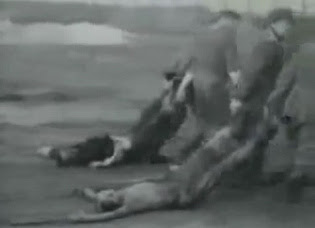


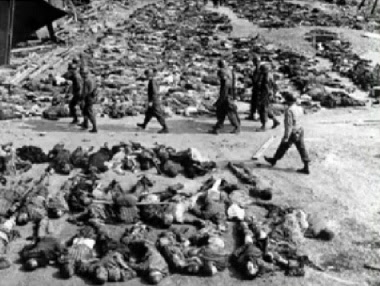

![Liberation of Bergen Belsen, well nourished Jewish detainees with German striped detainee suits and caps on a cold day in wet and cold April 1945, April 15, 1945 [5]; other web sites state that this photo would be from Dachau. Liberation of Bergen Belsen, well nourished Jewish detainees with German striped detainee suits and caps on a cold day in wet and cold April 1945, April 15, 1945 [5]; other web sites state that this photo would be from Dachau.](https://ci3.googleusercontent.com/proxy/q_W98rBoz94Al1Neb236eNw_u2fR_SBo792VzMRUTg6fVeP4a_Wp0OKtwk6u04FF8LYPM2mTr4EtGrv6bV6O2GbpoZW7iwwHlIVOcLmZFp7RKnJAZDXrwIvcxbx3XRaRsWXDmh4_Snq_-OMjPNw9taecALq7eEi6fjcEsKFmUzbKdHYedLwQnOi-W7oGRl5PIoVeqZx9LpHz_9Zf2X5HY9M=s0-d-e1-ft#http://www.hist-chron.com/eu/D/1945-rheinwiesenlager/ENGL/004-d/005-Liberation-Bergen-Belsen-well-nourished-detainees-w-caps-April15,1945.jpg)
